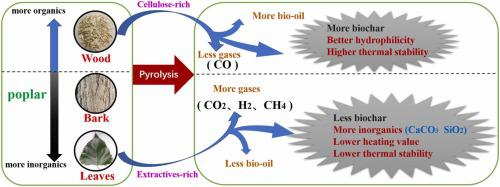Industrial Crops and Products ( IF 5.6 ) Pub Date : 2023-06-08 , DOI: 10.1016/j.indcrop.2023.117001 Li Qiu , Chao Li , Shu Zhang , Shuang Wang , Bin Li , Zhenhua Cui , Yonggui Tang , Xun Hu

|
The biochemical composition of wood, bark, and leaves is different, and this difference will inevitably project to products from the pyrolysis of different parts of a tree. In this study, different tissues of the same poplar tree (wood, bark, and leaves) were pyrolyzed to probe the characteristics of pyrolysis products of varied feedstock. The results indicated that wood tended to be pyrolyzed to form bio-oil with the highest yield (57.7% at 600 °C) while gases with the lowest yield (12.2% at 400 °C) among the three feedstocks. The high content of inorganic species in bark (5.8%) and especially leaves (10.3%) promoted the gasification of the aliphatic structures to produce a high yield of gases (18.9% of gas yield in leaves pyrolysis at 600 °C). In addition, unlike that in pyrolysis of wood, the pyrolysis of leaves produced little sugar derivatives like ketones (0%) /aldehydes (0%), but more hydrocarbons, N-containing organics, and phenolics with large fused ring structures. The organic components in leaves and bark were highly unstable, and their decomposition was further enhanced with the abundant inorganic species. This hindered the aromatization of the leaves/bark-derived biochar, resulting in their lower heating value, energy density, thermal stability, and their lower comprehensive combustion index than the biochar derived from wood. Additionally, as the pyrolysis temperature increases, the varied composition of feedstock also led to distinct patterns for the evolution of functionalities of biochar.
中文翻译:

生物炭与同源杨木、树皮和树叶热解的不同性质
木材、树皮和树叶的生化成分不同,这种差异将不可避免地反映到树的不同部分的热解产物中。在这项研究中,对同一棵杨树的不同组织(木材、树皮和树叶)进行了热解,以探究不同原料的热解产物的特性。结果表明,在三种原料中,木材倾向于热解形成最高产率的生物油(600 °C 时为 57.7%),而气体的产率最低(400 °C 时为 12.2%)。树皮 (5.8%) 尤其是树叶 (10.3%) 中无机物含量高,促进了脂肪族结构的气化,从而产生高产率的气体(600 °C 时树叶热解的气体产率为 18.9%)。此外,与木材的热解不同,叶子的热解产生很少的糖衍生物,如酮 (0%) / 醛 (0%),但产生更多的碳氢化合物、含氮有机物和具有大稠环结构的酚类化合物。树叶和树皮中的有机成分非常不稳定,随着无机物的丰富,它们的分解进一步加剧。这阻碍了树叶/树皮生物炭的芳构化,导致其热值、能量密度、热稳定性和综合燃烧指数均低于木材生物炭。此外,随着热解温度的升高,原料的不同组成也导致生物炭功能演变的不同模式。树叶和树皮中的有机成分非常不稳定,随着无机物的丰富,它们的分解进一步加剧。这阻碍了树叶/树皮生物炭的芳构化,导致其热值、能量密度、热稳定性和综合燃烧指数均低于木材生物炭。此外,随着热解温度的升高,原料的不同组成也导致生物炭功能演变的不同模式。树叶和树皮中的有机成分非常不稳定,随着无机物的丰富,它们的分解进一步加剧。这阻碍了树叶/树皮生物炭的芳构化,导致其热值、能量密度、热稳定性和综合燃烧指数均低于木材生物炭。此外,随着热解温度的升高,原料的不同组成也导致生物炭功能演变的不同模式。且其综合燃烧指数低于源自木材的生物炭。此外,随着热解温度的升高,原料的不同组成也导致生物炭功能演变的不同模式。且其综合燃烧指数低于源自木材的生物炭。此外,随着热解温度的升高,原料的不同组成也导致生物炭功能演变的不同模式。









































 京公网安备 11010802027423号
京公网安备 11010802027423号